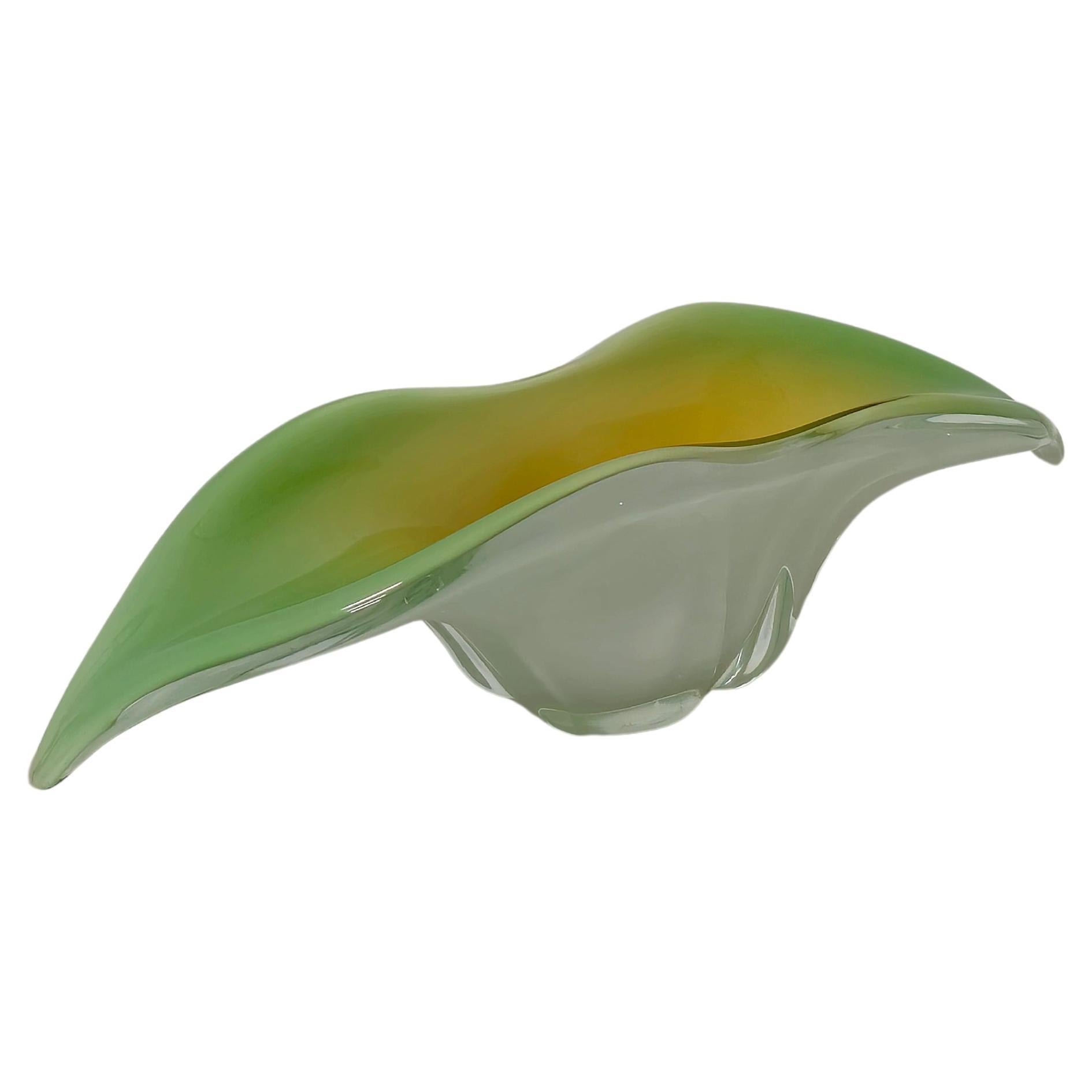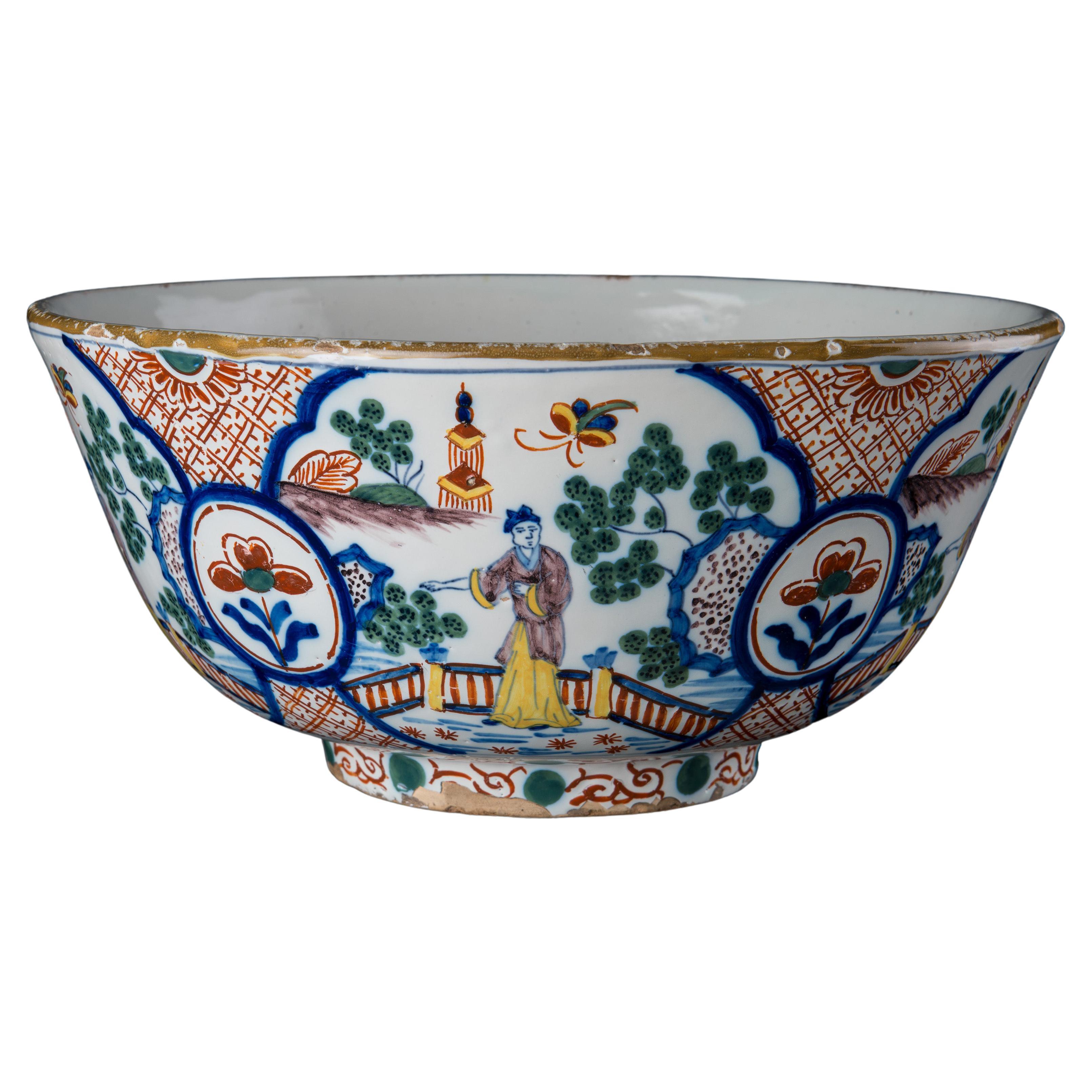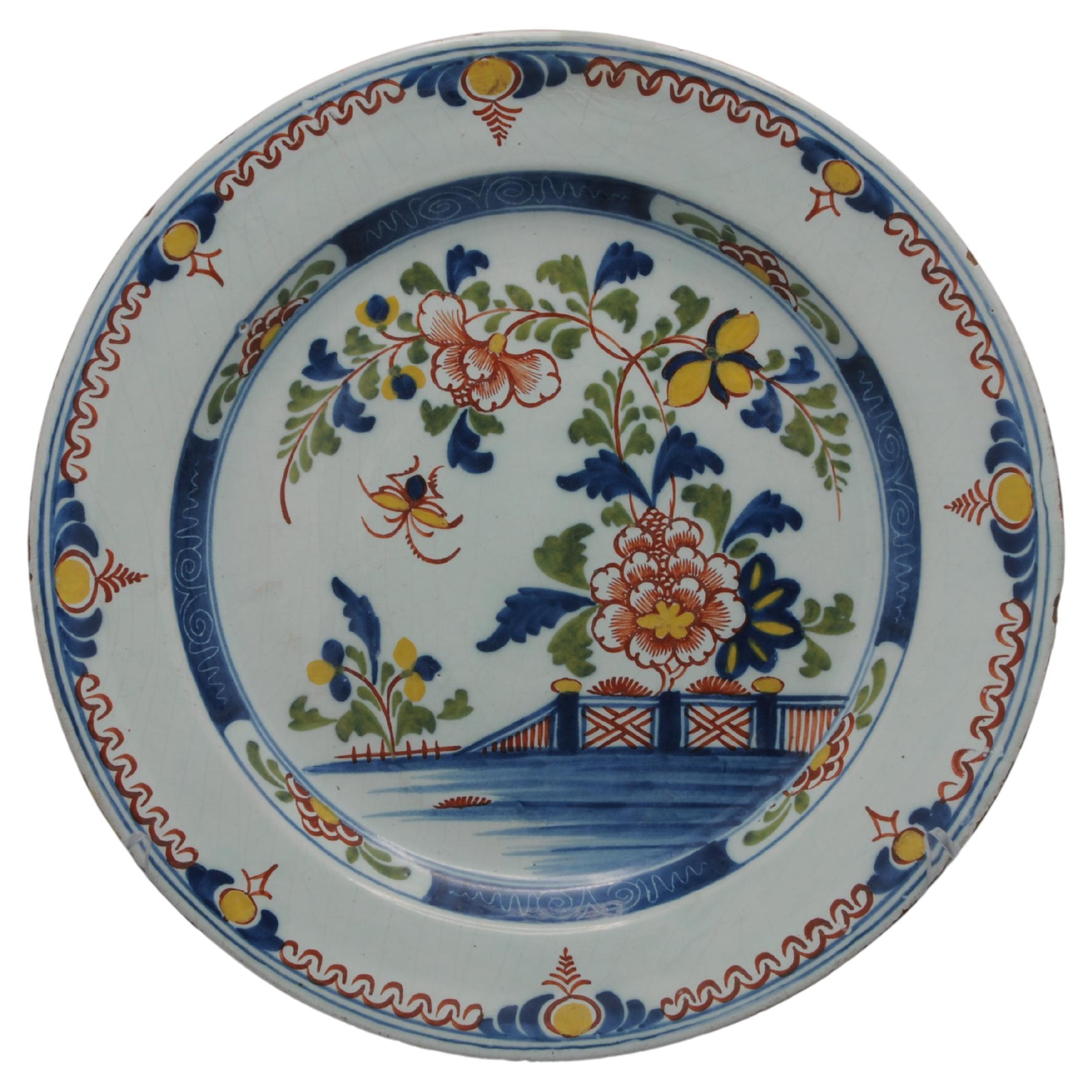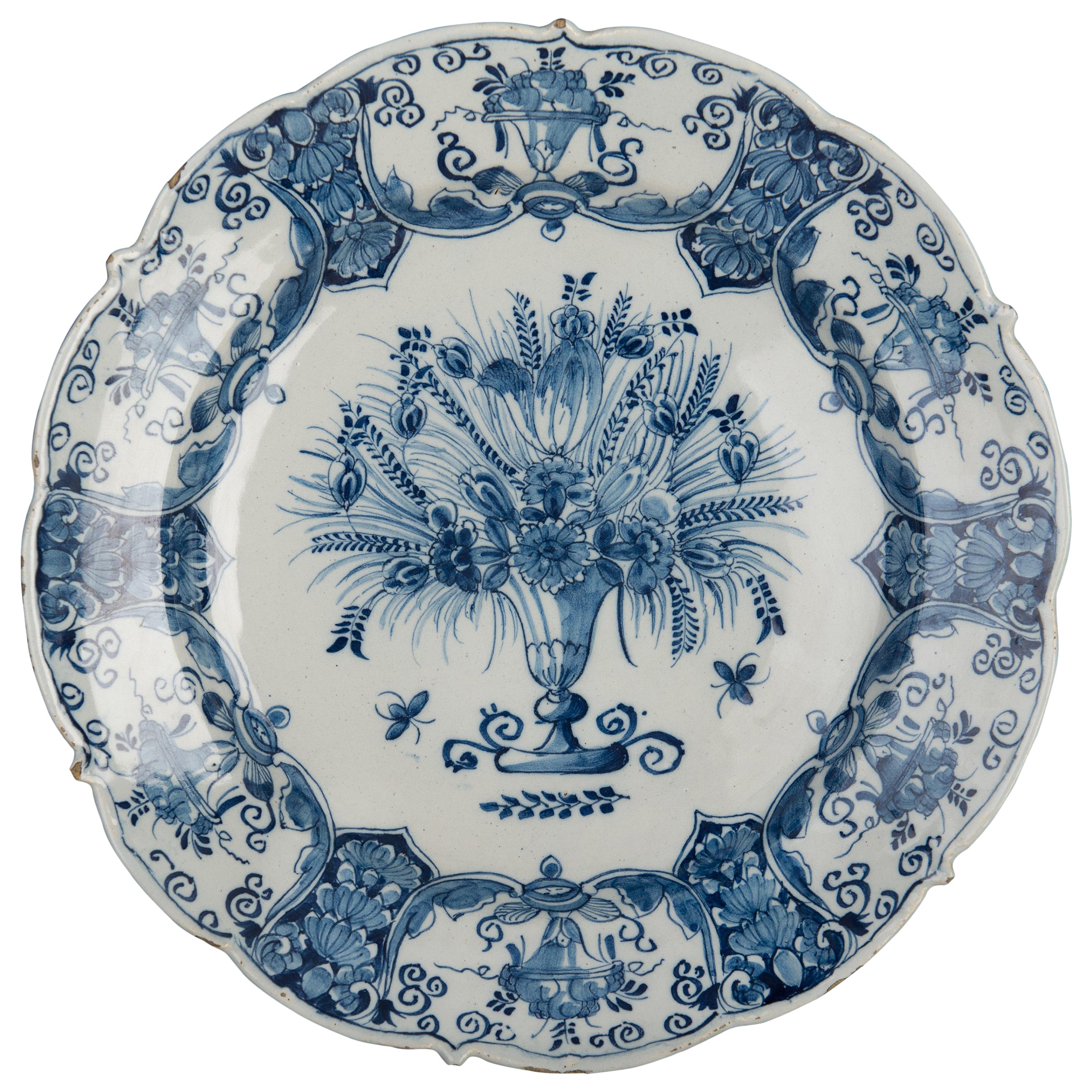Items Similar to Delft, Blue and White Dragon Dish Mark AIK, Period J van der Kool '1722-1757'
Want more images or videos?
Request additional images or videos from the seller
1 of 8
Delft, Blue and White Dragon Dish Mark AIK, Period J van der Kool '1722-1757'
About the Item
Blue and white dragon dish. Delft, 1722-1757
The Greek A pottery Mark: AIK, period J van der Kool (1722-1757)
Dish with blue and white decoration of a dragon on a dense ground of flowers and foliage. The well is undecorated. The border is painted with six cartouches, each filled with three peaches each and separated from one another by trellis-work.
Judging from a large number of surviving pieces, this decoration must have enjoyed considerable popularity in the eighteenth century. It is used on teapots, salts, vases, pots, bowls, tea caddies, beer jugs, spittoons, oil and vinegar sets, puzzle jugs and even egg cups. Customers could perhaps put together a service themselves by combining different shapes with this decoration.
The border with cartouches and trellis-work is copied directly from Chinese porcelain plates and bowls of the Kangxi period (1662-1722). However, the centre decoration has no direct parallel from the Kangxi period. Dragons or other animals on a dense ground of flowers and foliage were painted on Chinese porcelain as early as the sixteenth century, and such a decoration probably served as a model for this Delft design. The dragon decoration was most likely developed at The Greek A pottery. The earliest pieces known are two pots and a vase with the AK mark for Adriaen Kocxs (1686-1701). They are in the collections of the Victoria & Albert Museum.
Dimensions: diameter 34.5 cm / 13.38 in. Condition: is very good considering its age of 280 years. Usual small rim chips.
I carefully package all items in a double-box and use first-class packaging material.
- Creator:Dutch Originals (Maker)
- Dimensions:Height: 2 in (5.08 cm)Diameter: 13.38 in (33.99 cm)
- Style:Baroque (Of the Period)
- Materials and Techniques:
- Place of Origin:
- Period:
- Date of Manufacture:1722-1757
- Condition:Wear consistent with age and use. Very good, considering its age of 280 years and usage. Usual minor wear to the Rim.
- Seller Location:Verviers, BE
- Reference Number:1stDibs: LU1441224770452
About the Seller
4.9
Platinum Seller
These expertly vetted sellers are 1stDibs' most experienced sellers and are rated highest by our customers.
Established in 2000
1stDibs seller since 2015
700 sales on 1stDibs
Typical response time: 2 hours
- ShippingRetrieving quote...Ships From: Velddriel, Netherlands
- Return PolicyA return for this item may be initiated within 3 days of delivery.
Auctions on 1stDibs
Our timed auctions are an opportunity to bid on extraordinary design. We do not charge a Buyer's Premium and shipping is facilitated by 1stDibs and/or the seller. Plus, all auction purchases are covered by our comprehensive Buyer Protection. Learn More
More From This SellerView All
- Delft, Large Blue and White Dish with Flower Vase, 1750, the Three Bells PotteryBy Dutch OriginalsLocated in Verviers, BEBlue and white dish with flower vase. Delft, 1740-1760 The Three Bells pottery. Mark: three bells Dish with a scalloped rim painted in blue showing a ...Category
Antique Mid-18th Century Dutch Baroque Delft and Faience
MaterialsCeramic, Faience
- Delft, Porceleyne Fles Applique after a Painting by E. Verveer, 1903By De Koninklijke Porceleyne FlesLocated in Verviers, BEDelft, Porceleyne Fles Applique after a Painting by E. Verveer, made 1903 A Porceleyne Fles delft hand painted applique after a painting by Elchanon Leonardus Verveer. . The appliq...Category
Early 20th Century Dutch Delft and Faience
MaterialsCeramic
- Delft, Porceleyne Fles Applique after a Painting by E. Verveer, 1901By De Koninklijke Porceleyne FlesLocated in Verviers, BEDelft, Porceleyne Fles Applique after a Painting by E. Verveer, made 1901 A Porceleyne Fles delft hand painted applique after a painting by Elchanon Leonardus Verveer. . The appliq...Category
Early 20th Century Dutch Delft and Faience
MaterialsFaience, Ceramic
- Delft, Porceleyne Fles Tile Panel after a Painting by MesdagBy Royal DelftLocated in Verviers, BEA very fine Porceleyne Fles Delft hand painted large tile panel after a painting by H.W. Mesdag. The tile panel is executed in Delft blue color. The panel consists of 20 tiles and is...Category
Early 20th Century Dutch Delft and Faience
MaterialsCeramic, Oak
- Delft, Porceleyne Fles Tile Panel after a Painting by MesdagBy Royal DelftLocated in Verviers, BEA very fine Porceleyne Fles Delft hand painted tile panel after a painting by H.W. Mesdag. This tile panel is executed in Delft blue colour. The panel consists of 6 tiles and is pain...Category
Early 20th Century Dutch Delft and Faience
MaterialsCeramic, Oak
- Delft, Porceleyne Fles Tile Panel after a Painting by Du ChattelBy Royal DelftLocated in Verviers, BEA Porceleyne Fles delft hand painted large tile panel after a painting by Du Chattel. The tile panel is executed in sepia color. The panel consists of 20 tiles and is painted by Porceleyne fles factory, circa 1900. There is a painter’s mark but I have not yet been able to identify the painter. Established in 1653, De Koninklijke Porceleyne Fles is the only remaining delft blue pottery...Category
Early 20th Century Dutch Delft and Faience
MaterialsCeramic, Oak
You May Also Like
- 'De Grieksche A', Jacob van der Kool, Delft - Large Chinoiserie style ChargerBy De Grieksche ALocated in DELFT, NLExtraordinary Blue Delftware (deep) platter with chinoiserie decoration of three birds above blossoming peony and flower sprays. The border and with a decoration of tracery and carto...Category
Antique Early 18th Century Dutch Delft and Faience
MaterialsEarthenware, Faience
- Polychrome Chinoiserie Lobed Dish Delft, 1680-1690By Dutch OriginalsLocated in ROSSUM, GEPolychrome chinoiserie lobed dish. Delft, 1680-1690 The lobed dish is composed of nine wide lobes around a nine-fold centre and is painted with a chinoiserie decor in purple, yellow and green. Two Chinese figures in an eastern landscape are depicted in the centre, one of them carries a banner. The landscape is framed within lines and a white band. The border is decorated with a continuous landscape with two reclining and two standing Chinese figures. A lobed dish of the same shape and design in purple, blue and green is in the collection of the Victoria and Albert Museum in London. The Museum of Fine Arts in Boston, Massachusetts holds a variant in blue and yellow. In the same museum are three lobed dishes, each with twenty-seven double lobes with chinoiserie landscapes in the same colour scheme of purple, yellow and green. In the second half of the seventeenth century many lobed dishes were painted with Chinese motifs, mostly landscapes with Chinese figures. The vast majority are in blue. Two- or multi-coloured chinoiserie decorations were very fashionable during a short period of time, predominantly in the 1680s. In addition to lobed dishes, they also appear on wine jugs, beer mugs, butter pots, covered spiced-wine bowls and dishes. Some of this Delftware is still wrongly attributed to a factory in the German town of Frankfurt, and sometimes it is even considered to be English. An excavated chinoiserie butter pot in purple, green and yellow, found in a cesspit in the grounds of the Porcelain Bottle factory, proves otherwise. A beer mug with the portrait of the Dutch prince Willem III...Category
Antique 17th Century Dutch Baroque Delft and Faience
MaterialsCeramic, Faience
- Delft Blue and White Dish with Windmill, 1700-1750By DelftLocated in ROSSUM, GEBlue and white dish with windmill. Delft, 1700-1750 The dish has a raised flange and is painted in blue with a windmill between two sponged tr...Category
Antique Early 18th Century Dutch Baroque Delft and Faience
MaterialsCeramic, Faience
- Blue and White Chinoiserie Lobed Dish, Delft, 1650-1680By DelftLocated in ROSSUM, GEBlue and white chinoiserie lobed dish. Delft, 1650-1680 Dimensions: diameter 33,5 cm / 13.18 in. The blue and white lobed dish is composed of twenty-seven double lobes. The cur...Category
Antique Mid-17th Century Dutch Baroque Delft and Faience
MaterialsCeramic, Faience
- Large Delft Blue and White Charger with Landscape, Netherlands, circa 1660By Dutch OriginalsLocated in ROSSUM, GELarge Blue and white charger with landscape The Netherlands, circa 1660 The charger has a wide, spreading flange and is painted in b...Category
Antique Mid-17th Century Dutch Baroque Ceramics
MaterialsCeramic, Majolica
- Blue and White Chinoiserie Lobed Dish, Delft, 1650-1680By DelftLocated in ROSSUM, GEBlue and white chinoiserie lobed dish. Delft, 1650-1680 Dimensions: diameter 33,5 cm / 13.18 in. The blue and white lobed dish is composed of twenty-s...Category
Antique Mid-17th Century Dutch Baroque Delft and Faience
MaterialsCeramic, Faience
Recently Viewed
View AllMore Ways To Browse
Antique Dutch Plates
Dutch Kitchen
Dutch Painted Glass
Antique Chinese Silver Marks
Delft Blue And White
Blue White Faience
Glass Dragon
Antique Delft Blue And White
Delft Blue Holland
Antique Faience Pottery
Holland Dutch Pottery
Dutch Blue Ceramics
Delft Hand Painted In Holland
Dutch Delft Blue And White
Small Blue And White Plates
Large White Dish
Large Glass Egg
Blue And White Egg





